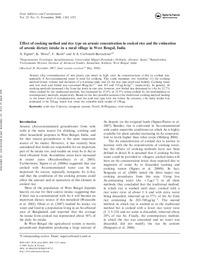Title:
Effect of cooking method and rice type on arsenic concentration in cooked rice and the estimation of arsenic dietary intake in a rural village in West Bengal, India |
Authors:
Signes-Pastor, Antonio Jose 
Mitra, K.
Burló, Francisco 
Carbonell-Barrachina, Ángel A. |
Editor:
Taylor & Francis |
Department:
Departamentos de la UMH::Salud Pública, Historia de la Ciencia y Ginecología
Departamentos de la UMH::Tecnología Agroalimentaria |
Issue Date:
2008-11 |
URI:
https://hdl.handle.net/11000/34414 |
Abstract:
Arsenic (As) contamination of rice plants can result in high total As concentrations (t-As) in cooked rice,
especially if As-contaminated water is used for cooking. This study examines two variables: (1) the cooking
method (water volume and inclusion of a washing step); and (2) the rice type (atab and boiled). Cooking water
and raw atab and boiled rice contained 40 mg As l!1 and 185 and 315 mg As kg!1, respectively. In general, all
cooking methods increased t-As from the levels in raw rice; however, raw boiled rice decreased its t-As by 12.7% when cooked by the traditional method, but increased by 15.9% or 23.5% when cooked by the intermediate or contemporary methods, respectively. Based on the best possible scenario (the traditional cooking method leading to the lowest level of contamination, and the atab rice type with the lowest As content), t-As daily intake was estimated to be 328 mg, which was twice the tolerable daily intake of 150 mg.
|
Keywords/Subjects:
atab rice
Calcutta
inorganic arsenic
North 24-Parganas
total arsenic |
Type of document:
info:eu-repo/semantics/article |
Access rights:
info:eu-repo/semantics/openAccess
Attribution-NonCommercial-NoDerivatives 4.0 Internacional |
DOI:
10.1080/02652030802189732 |
Published in:
Food Additives and Contaminants, Vol. 25, No. 11, November 2008, 1345–1352 |
Appears in Collections:
Artículos Salud Pública, Historia de la Ciencia y Ginecología
|

.png)
